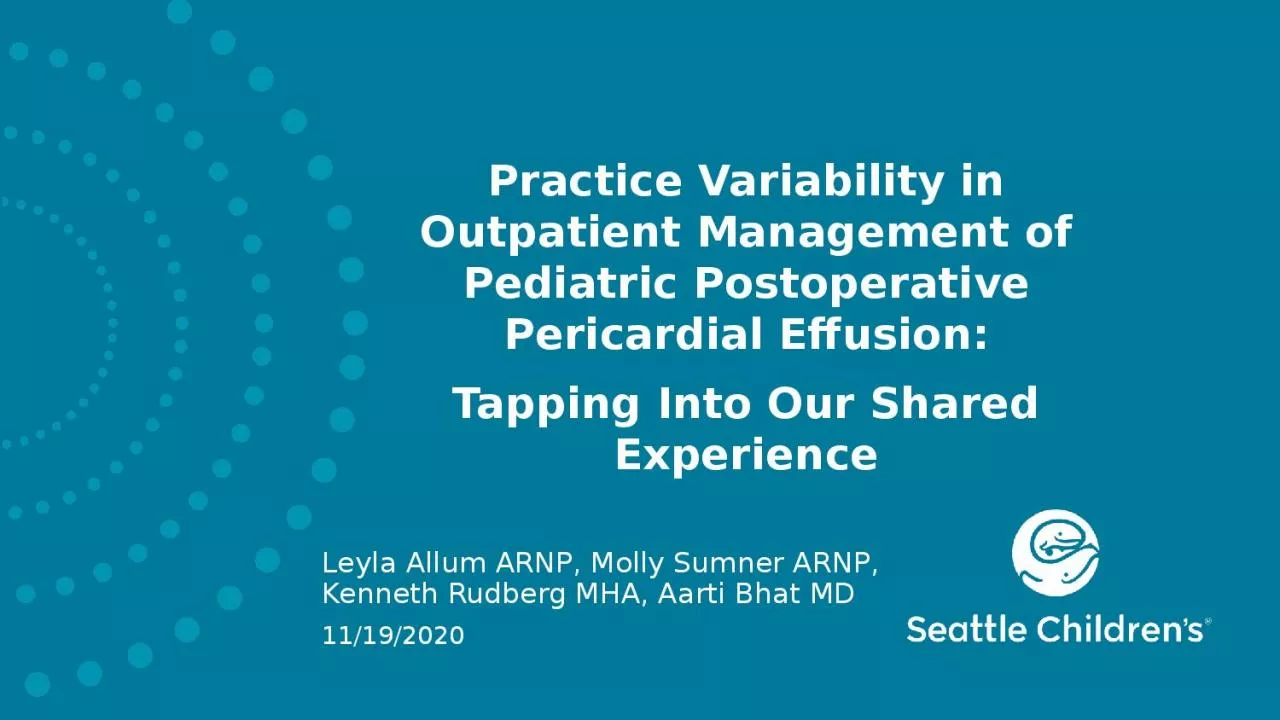

Tapping Into Our Shared Experience Leyla Allum ARNP Molly Sumner ARNP Kenneth Rudberg MHA Aarti Bhat MD 11192020 Background Pericardial effusion PE and postpericardiotomy syndrome PPS are frequent and well known postoperative complications in patients who have undergone cardiac surger ID: 1041640
Download Presentation The PPT/PDF document "Practice Variability in Outpatient Manag..." is the property of its rightful owner. Permission is granted to download and print the materials on this web site for personal, non-commercial use only, and to display it on your personal computer provided you do not modify the materials and that you retain all copyright notices contained in the materials. By downloading content from our website, you accept the terms of this agreement.
1. Practice Variability in Outpatient Management of Pediatric Postoperative Pericardial Effusion:Tapping Into Our Shared ExperienceLeyla Allum ARNP, Molly Sumner ARNP, Kenneth Rudberg MHA, Aarti Bhat MD11/19/2020
2. BackgroundPericardial effusion (PE) and post-pericardiotomy syndrome (PPS) are frequent and well known post-operative complications in patients who have undergone cardiac surgeryPE occurs in ~20% of children undergoing cardiac surgery (Adrichem et al 2019)In 80% of patients, it occurs within the first post-op month (Adrichem et al 2019)Although there are clear practice recommendations in the adult population, best practice guidelines for the management of PE/PPS in the pediatric setting are lacking
3. AimsDetermine cardiologists’ practice preferences regarding the outpatient management of clinically relevant PE/PPS after discharge from cardiac surgery Explore need for protocol for identification and management of post of PE/PPS
4. MethodsA 15-item REDCap survey was distributed via email to pediatric cardiologists, who practice at our tertiary hospital as well as 6 regional satellite sitesSurvey was focused on capturing practice preferences for treatment of postoperative PE/PPSSurvey questions included diagnosis, pharmacologic preferences and outpatient management of postoperative PE/PPS
5. ResultsResponses were received from 30 out of 41 cardiologists (response rate 73%)Cardiologist’s years in practice ranged from <1 year to 35 years (median 15 years)30% of cardiologists reported they would treat a small-moderate PE57% of cardiologists reported they would treat a moderate PE
6. Results: pharmacologic choices First line therapy choice: Ibuprofen (65%), Diuretics (30%), Colchicine (3%), Steroids (3%)Second line therapy choice: Colchicine (23%), Steroids (37%) Third line therapy choice: Colchicine (43%), Steroids (47%)No correlation based on cardiologist’s years in practiceResponse to: “Please order the following treatment options according to your preferences of utilization: Ibuprofen, Colchicine, Prednisone/Prednisolone, Diuretics”
7. ConclusionsThere is significant variability in outpatient management of pediatric postoperative pericardial effusion after cardiac surgeryTwo-thirds of cardiologists surveyed prefer NSAIDs as first line therapyAlmost no one selected colchicine as first line therapy, contrary to adult practice (Imazio et al 2010) A limitation in our survey was lack of clarity around the use of monotherapy versus dual therapy (specifically the concurrent use of diuretics). Our survey highlights room for improvement in standardized treatment of pediatric postoperative pericardial effusion
8. AcknowledgementsThank you to the Seattle Children’s Hospital Cardiologists for their survey participationReferencesAdrichem, R., Le Cessie, S., Hazekamp, M. G., Van Dam, N. A. M., Blom, N. A., Rammeloo, L. A. J., Filippini, L. H. P. M., Kuipers, I. M., Ten Harkel, A. D. J., & Roest, A. A. W. (2019). Risk of Clinically Relevant Pericardial Effusion After Pediatric Cardiac Surgery. Pediatric cardiology, 40(3), 585–594. https://doi.org/10.1007/s00246-018-2031-4Imazio, M., Trinchero, R., Simon, C., Sansone, F., Patrini, D., Vitali, E., Ferrazzi, P., Spodick, D. H., Adler, Y., Brucato, A., Rovere, M. E., Gandino, A., Cemin, R., Ferrua, S., Maestroni, S., Zingarelli, E., Barosi, A., & COPPS Investigators. (2010). Colchicine for the Prevention of the Post-pericardiotomy Syndrome (COPPS): a multicentre, randomized, double-blind, placebo-controlled trial. European Heart Journal, 31(22), 2749–2754.
9.